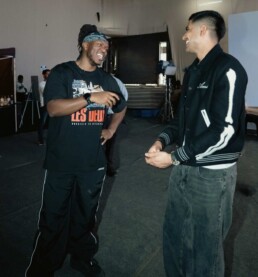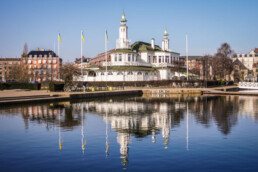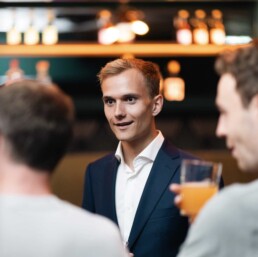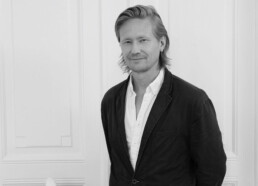From Copenhagen to Global Stars’ Instagram Feeds
From Copenhagen to Global Stars’ Instagram Feeds
🇩🇰 Du finder den danske version af denne artikel her.
KSI, Drake and TJ Edwards – what do they have in common?
Over the course of just a few days, the Danish fashion brand Les Deux has appeared on a number of high-profile international figures.
The brand has been widely exposed across Instagram, including on Drake’s account with its 142 million followers, as well as through KSI, Chicago Bears player TJ Edwards and cricketer Shubman Gill.
Gill, in particular, is regarded as one of the most promising young batters in world cricket today, with close to 18 million followers of his own.
The intersection of sport, music and cultural figures wearing Les Deux has long been one of the brand’s key growth drivers. Unlike many fashion brands, however, paid exposure has never been part of its strategy.
According to our information, that remains the case here. The appearances have been entirely organic, with no outreach from the brand itself. No campaign. No sponsorship.
Quantifying the value is difficult, but a single image featuring a Les Deux cap has already attracted more than one million likes, alongside extensive engagement in the comments.
The impact is undeniable when content reaches millions of followers through some of the world’s most recognisable names.
"All exposure has been entirely organic"
One of many developments from Les Deux
This is just one of several developments surrounding Les Deux at the moment, as the brand looks ahead to another year of growth and strong results.
On its home turf, Les Deux recently extended its partnership with F.C. Copenhagen, which faces two major Champions League fixtures this January: a home match against Italian champions Napoli, followed by an away game against the European powerhouse FC Barcelona.
Meanwhile, the brand has signalled further expansion in the UK and opened a new flagship store in Paris, strengthening its presence on international markets. (Read more about the UK here & learn more about Paris here.)
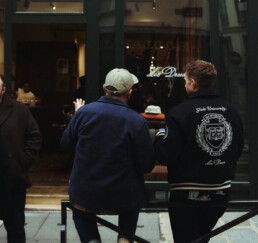
Flere artikler som denne?
Hold dig opdateret på de mest spændende historier, tips og interviews.
Tilmeld dig vores nyhedsbrev og få det hele direkte i inboxen.
Allerede 60.000+ på listen. Vi sender ud 1 gang om ugen!
Copenhagen Iconic Venue and Danish Startup Reinvent the Cloakroom
Copenhagen Iconic Venue and Danish Startup Reinvent the Cloakroom
🇩🇰 Du finder den danske version af denne artikel her.
One is one of Copenhagen’s most iconic nightlife venues. The other is an ambitious Danish tech company, focused on solving a problem that has existed for decades.
Søpavillonen has partnered with Keypitt™ to digitize its cloakroom, replacing the traditional paper ticket with a personal, digital KeyPass. Guests set it up once and can store it in their digital wallet—no app required.
While the cloakroom might seem like a small detail, it is here that the pace truly picks up. According to Søpavillonen, the move isn’t about technology for technology’s sake—it’s about flow, safety, and creating a better working environment.
"We’ve spent more than 300 hours testing and developing the system alongside industry professionals”
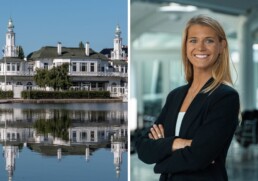
Co-founder Karla Pitt Winther, Keypitt™
The cloakroom is a key touchpoint for our guests
Jon Vanggaard Thomsen, owner and partner at Søpavillonen, explains:
“The cloakroom is a key touchpoint for our guests, especially on busy nights. With Keypitt™, we can reduce queues, improve safety, and offer a better experience for both guests and staff. It’s a simple, yet significant upgrade to a long-standing function.”
Keypitt™, the provider behind the system, is a Danish tech company that develops digital cloakroom solutions for nightlife venues, concert halls, conference centres, and arenas.
Tests from other venues suggest that throughput can be increased significantly, while the number of lost items is reduced. If something is left behind, the owner can be easily contacted via the phone number linked to their digital KeyPass.
Earlier this year, the company also managed the cloakroom at TECHBBQ, serving over 10,000 guests.
Co-founder Karla Pitt Winther adds:
“The cloakroom has remained virtually unchanged for over a century. We’ve spent more than 300 hours testing and developing the system alongside industry professionals to create a solution that truly improves flow and adds value for guests, staff, and venues alike.”
She continues that the implementation at Søpavillonen is part of a broader trend, where cultural and nightlife venues are increasingly digitizing operational functions—not to change the atmosphere, but to remove the small friction points that can otherwise weigh heavily on the experience.
More articles like this?
Stay in the loop with the most exciting stories, tips, and interviews.
Sign up for our newsletter and have it delivered straight to your inbox.
Join over 60,000 subscribers. We send updates just once a week!
Bjarke Just Nielsen is reshaping Copenhagen’s restaurant scene
Bjarke Just Nielsen is reshaping Copenhagen’s restaurant scene
🇩🇰 Du finder den danske version af denne artikel her.
A conversation with Bjarke Just Nielsen
To many, his trajectory might read like the result of a long career. In reality, most of it has been built in just five or six years. Today, Bjarke Just Nielsen stands behind 17 restaurants, several cafés and bakeries across Copenhagen, three IT platforms, and a production facility.
Educated at Copenhagen Business School, Nielsen brings a more academic background than most restaurateurs. His story has been told before, but it is precisely this unconventional route into the industry that makes it interesting.
Which ideas and tools did he carry with him, and how have they helped shape a company that has grown rapidly, deliberately, and with data as a central driving force?
"I have never been afraid of failure if I could see that I had done my best"
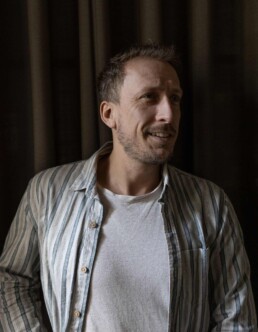
Bjarke Just Nielsen
Facts about the Norrlyst Group
The Norrlyst Group has grown from one to 17 restaurants in just six years. In June 2025, the group and Restaurant Udtryk earned their first Michelin star only 41 days after opening. Most recently, Norrlyst opened Lille Mølle.
Beyond its restaurants, the group also operates three IT platforms and a production facility.
Bjarke, if we rewind the clock, was it written in the stars that you would one day build your own company?
“It’s always interesting to look back. I never had a master plan. My first proper job was at Færgekroen in Tivoli when I was 14 or 15, and at the time I was simply happy to have work at all. I’d sent out countless applications.
That’s where I first caught the service bug. It led me to study Business Administration with a focus on Service Economics, followed by a master’s degree in Supply Chain Management. In many ways, that academic path is also what landed me, straight after my studies, in a suit and tie.”
After CBS, Bjarke joined Novo Nordisk’s Talent Track and was subsequently accepted into Ørsted’s graduate program, a highly selective process with over 8,000 applicants and only about 20 making it through.
Bjarke also reflects that rather than constantly switching jobs because he felt they weren’t the right fit, he had to look inward and realize that it was more likely him who didn’t fit the companies, rather than the other way around.
Bjarke continues:
“I’ve never been afraid of failure, as long as I knew I had given my best. I love creating and making things succeed, and many of my victories in life have been pure work victories. I’m rarely the most talented person in the room from the start, but I often manage to come out ahead. That’s why I think it was always in the cards for me to become an entrepreneur.
I have a strong work ethic, a high tolerance for risk, and I feel lucky to be able to manage my own schedule. It has been an enormous privilege, especially after starting my own family. I love being able to drop the kids off at nine and pick them up again at three. So maybe the answer to your question is a resounding yes.”
"To be honest, there was no grand plan from the start"

The Norrlyst Group has just turned five. How do you remember the early days, and what was the plan?
“To be honest, there wasn’t a grand plan. I had simply decided that I no longer wanted to sit in a suit. We started without spreadsheets or elaborate concepts. It’s actually quite the opposite of how we run the business today. And yet, somehow it worked.
We quickly learned to listen to our customers, take notes, and put our ideas into a system. Looking back, that was when we first started working with data, which today forms the foundation of the group.”
“My first head chef was Thilde Gilling, known in the industry as the Smørrebrød Queen, so we started with smørrebrød. Later, Emil Eshardt-Nielsen joined the team. He had experience from Søllerød Kro, Restaurant AOC, and Winterspring, and he helped shape much of the direction we follow today. Emil remains one of my closest collaborators and now serves as CPO.”
“And how do I remember that time? It moved fast. I was a builder, waiter, restaurant manager, and problem solver all at once. If we got feedback on poor acoustics on a Monday, we’d install a new acoustic ceiling by Tuesday. If a toilet was blocked, I fixed it. Work has never intimidated me, and I’ve always known that you don’t need a perfect plan from the start to reach your goal.”
“Corona hit shortly after we opened, so in a way, we were almost born as an agile company, constantly having to adapt to the situation at hand.”
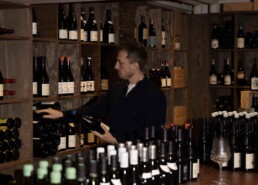
Data is key: "Trust the algorithm"
Speaking of data, FreeTable is a chapter of its own. What inspired you to create it, and how does it connect to Norrlyst?
“The core idea behind FreeTable was to revolutionize how people book tables at restaurants, just as we’ve seen happen in many other sectors of the experience economy. At the same time, the project builds on our understanding and collection of data.”
“We wanted to bring the entire restaurant industry along, make it more automated, and create a win-win for both restaurants and guests. Anyone can use the platform. It’s an additional booking system, but the real goal is the product itself—our own algorithm, which has cost millions to develop.”
“It’s a formula that can change the way we think about dining out, both for guests and restaurateurs. It’s about being present, being your own best friend, and trusting the algorithm.”
“It has already given us a stable baseline, with our restaurants running safely at 10–12 percent EBITDA. Some might call it boring, but predictability and stability are exactly what the industry needs. Hotels and airlines are far ahead of us with dynamic pricing, and I see that as a huge opportunity for the restaurant world. Price optimization can mean many things, from menus to bookings, and we believe this is the path the industry should take.”
In the new year, you can read an article on FreeTable and its ambitions on dontt.dk, where Bjarke offers a unique insight into a massive dataset.
"I still love my work and look forward to every day I go into the office"
How does your typical day look today?
“I still love my work and look forward to every day at the office. But family is, of course, important, with two young children at home. I make it a priority to drop off and pick up my kids, and I’ve moved into a more strategic role within the group, which gives me that freedom.
I’m no longer involved in day-to-day operations, so I can think further ahead and focus on development. Some of my closest friends are also part of the company, so work and social life often blend together.”
What drives you personally?
“I’m driven by the passion to see how far we can take this. It’s still exciting to challenge the IT side, look at acquisitions, and explore new directions.
I work with many small milestones. It could be a Michelin star, employee satisfaction, or new concepts. That’s what motivates me. The most important thing is that we give our best and don’t stagnate in our development.”
Claus Meyer has been a huge inspiration
Who inspires you?
“I’ve never been the type to have lots of idols or people I follow religiously. But Claus Meyer has been a huge inspiration. He has left a clear mark on the industry and changed things ahead of his time.
We still celebrate many of the initiatives he set in motion. I’ve read his biography, which says something, because I rarely read books. I much prefer listening.
In general, I’m very focused and keep my nose in my own business. I’m not someone who is constantly updated on media or trends. I put my energy into our own journey.”
How do you see Norrlyst in five years?
“We approach strategy very differently today, so of course there are many plans. But I still don’t think you can plan that far ahead. The last five years have shown that anything can happen.
That’s why we build the company to be able to adapt quickly. As you reach a certain size, decisions take longer, but flexibility remains a key principle. We need to be ready for the unpredictable while holding on to the stable foundation we’ve built.”
More articles like this?
Stay in the loop with the most exciting stories, tips, and interviews.
Sign up for our newsletter and have it delivered straight to your inbox.
Join over 60,000 subscribers. We send updates just once a week!
Billi Bi recruits global ECCO executive
Billi Bi recruits global ECCO executive
🇩🇰 Du finder den danske version af denne artikel her.
Next year, Danish footwear brand Billi Bi will celebrate its 90th anniversary, if one counts the founding of its parent company, Fransi, in 1936 by the grandparents of current owner Carsten Friis. Billi Bi itself was launched in 1993, carrying forward a legacy of craftsmanship and design.
The name, delightfully, comes from Friis’ favourite dish: the French mussel soup Billi Bi, first served at the legendary Parisian restaurant Maxim’s in the 1930s, a story as charming as it is tangential to the shoes themselves.
“Billi Bi is built on a solid foundation”
Despite its long history, Billi Bi shows no signs of slowing down. With ambitions to expand its presence on the international stage, the company is strengthening its leadership team.
Justin Daughrity-Winther joins the brand in a newly created role as Chief Commercial Officer (CCO), taking responsibility for refining Billi Bi’s commercial strategy and ensuring a seamless dialogue between brand identity, collections, and distribution. Daughrity-Winther brings over a decade of international experience in footwear, most recently serving as Global Vice President of Brand at ECCO.
“Billi Bi is built on a strong foundation and already experiencing healthy growth,” says Carsten Friis, CEO and owner. “Bringing Justin on board allows us to further accelerate this development, both across the Nordics and internationally. His strategic vision and commercial expertise align perfectly with the direction we want to take the brand.”
With this appointment, Billi Bi signals its intent to marry its rich heritage with a forward-looking strategy, embracing new markets and audiences while staying true to the craftsmanship and quality that have defined the brand for nearly three decades.
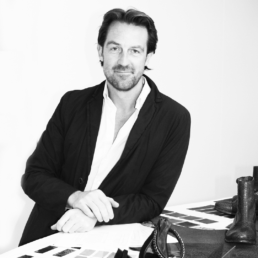
Carsten Friis, CEO and owner
Flere artikler som denne?
Hold dig opdateret på de mest spændende historier, tips og interviews.
Tilmeld dig vores nyhedsbrev og få det hele direkte i inboxen.
Allerede 55.500+ på listen. Vi sender ud 1 gang om ugen!
23-year-old Gustav built his own AI tool! 4 months later, hotels rely on it daily
23-year-old Gustav built his own AI tool! 4 months later, hotels rely on it daily
🇩🇰 Du finder den danske version af denne artikel her.
The idea for Opally didn’t emerge in a boardroom or at an innovation workshop. It was born in a hotel reception on Bornholm, and went live just nine days later.
Behind the AI tool is Danish 23-year-old Gustav Søgård. He studies cand.merc.(it.) at Copenhagen Business School and simultaneously works at Understory, which recently raised €12 million.
Yet he still found the time to build a tool that now helps hotels spend less time on emails and more time with the guests in front of them. Opally started as a solution for Stammershalle Badehotel in the summer, and today around a dozen hotels are already on board – with more joining soon.
Impressive, by any measure.
Here, Gustav shares his story, explaining the idea, his motivation, and how technology, paradoxically, can create more human jobs.
"I’m motivated by creating solutions that have a real impact on everyday life."
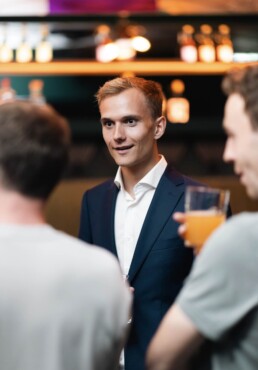
Gustav Søgård, Founder, Opally
Gustav, let’s get this straight! How would you explain Opally in 15 seconds to a hotel receptionist who has never used AI?
“I usually tell people to imagine having an extra colleague who knows all the answers to their guests’ questions, with full access to the hotel’s data.
Opally handles the ‘boring’ work and drafts emails based on guest inquiries, following the hotel’s preferred tone and style.
The receptionist only needs to check that everything looks correct and hit send. It’s not about replacing the front desk, but about reducing busywork so they can focus on the guests in the lobby.”
"Bring the product to life in the real world as fast as possible"
How did the idea for Opally come about?
“It all started in the summer of 2025 at Stammershalle Badehotel, where my mother works. I saw how much time the front desk spent answering the same types of emails over and over again, and I realized we could fairly easily build a solution that used data from their own systems to make it smarter.
The real spark came on July 8th at Paris Charles de Gaulle Airport, on my way home from a Y Combinator meetup with 800 other young startup enthusiasts. I was buzzing from the energy there, opened my laptop, and wrote the very first line of code right at the gate.”
How quickly did you implement it at Stammershalle?
“It happened fast. By July 17th – just nine days after I started coding in the airport – Stammershalle was already using the first version. It was a very simple version back then, but that’s the whole philosophy behind Opally: get the product out into the real world as quickly as possible so we can learn from it. The tight feedback loop between the code and the reception staff has been crucial from day one.”
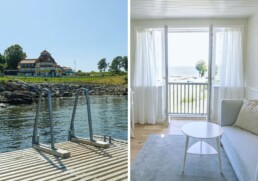
"Technology has always been a passion and an area of interest for me."
When did you realize that this wasn’t just a Stammershalle project, but something that could grow bigger?
“When I discovered how simple it actually was to swap out the ‘engine.’ I could take the system from Stammershalle and connect it to other hotel systems without much hassle.
And the thought was clear: If this can save Stammershalle so many hours a week, there are definitely other hotels out there facing the exact same challenge. Why not help them too?”
And now you’ve got other hotels on board?
“Yes, as of now we’re up to around 12 hotels. But that number changes almost week by week these days. We’re still in an early stage, but interest is high, so I expect growth to be really strong over the coming months.”
You’re studying cand.merc.(it.), building Opally, and working at Understory. What drives you?
“I’m driven by solving real problems in the real world. We live in a time where AI and technology are moving fast, but I believe the counter-reaction will be that people will want fewer things and more time together physically. My mission with Opally is to support the hospitality industry in that development.
We’re not here to remove receptionists; we’re here to remove screen time so they can focus on hosting and the guests standing right in front of them.
In effect, technology can help create better, more human jobs, rather than eliminating them.”
"Bring the product to life in the real“I’m inspired by those who can seamlessly connect technology with business”
What does a good workday look like for you?
“It’s a day with a lot of variety. I love the mix of commercial work, like onboarding and demos with hotels and diving deep into building new, value-creating features for the product.
My background in cand.merc.(it.) probably explains why I want to focus on both. I don’t just want to understand the business, or just the code. The magic happens when the two come together.”
Who inspires you?
“I’m drawn to people who are able to bridge the gap between technology and business.
Jack Dorsey, from Twitter and Square, is a big inspiration for his philosophy: if you have an idea, you should hack it to life and validate it in the real world immediately.
David Heinemeier Hansson is another huge influence for me and many other young people. He also studied HA(it.) at CBS, but his ability to understand how code directly contributes to business success over 20 years with Basecamp is truly unique.
And here at home, I’m very inspired by Lasse & Lars from Understory. They’re an incredible duo who just complement each other perfectly when building large businesses.”
"If I could give one piece of advice: learn to code"
If you could give one piece of advice to young entrepreneurs with an idea, what would it be?
“Learn to code. Even at a basic level. It’s by far the best way to get an idea out of your head and into the real world. Today, you don’t need to be an expert from the start, with AI tools like Cursor and Windsurf, you can achieve a lot with just a foundational understanding.
I also see ‘systems thinking’ becoming one of the most important skills for the future. In other words, the ability to understand how complex systems interact and where you can optimize the architecture. That’s where the real value lies.”
Want more stories like this?
Culture, business & inspiration — straight from Copenhagen to your inbox. Join over 55,500 subscribers! We send out updates once a week.
GANNI Founder Invests in Beauty Brand
GANNI Founder Invests in Beauty Brand
🇩🇰 Du finder den danske version af denne artikel her.
Today, Copenhagen-born beauty brand NUORI announces a new leadership structure and investment. Danish venture studio Twelve50Five, along with GANNI founder Nicolaj Reffstrup, are joining the company to support its next phase of growth.
Twelve50Five founder Malte Kamp Videbæk will assume the role of CEO. NUORI’s founders, Jasmi and Peter Bonnén, will remain minority shareholders and, according to Malte, take on advisory roles to ensure a smooth transition while preserving the brand’s founding values.
Reffstrup will not be involved in day-to-day operations but will, as a shareholder, provide strategic insight, particularly from a global perspective. His experience in scaling GANNI into one of Scandinavia’s most influential and commercially successful fashion brands speaks directly to the expertise he brings to NUORI.
"I have admired NUORI for years"
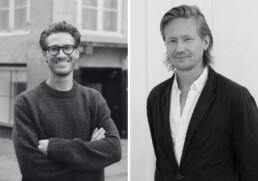
From left: Malte Kamp Videbæk and Nicolaj Reffstrup
"This marks an exciting new chapter for NUORI"
“This marks an exciting new chapter for NUORI,” says Jasmi Bonnén, Founder of NUORI. “In this new constellation NUORI will be better positioned than ever to fulfill the global potential of the brand. I’m proud of what we have built so far and excited to see NUORI reach new heights under the stewardship of Malte, Nicolaj and the combined NUORI & Twelve50Five teams.”
“NUORI has a rare and compelling positioning in the global beauty landscape: science- forward, naturally formulated, and rooted in a strong Nordic design ethos,” says Malte Kamp Videbæk, incoming CEO of NUORI. “This deal lays the foundation for significant growth. I look forward to working closely with the team to scale the brand globally while staying true to its core values.”
“I have admired NUORI for years,” says Nicolaj Reffstrup. “The brand has a strong identity, unique authenticity and a real commitment to quality and innovation. I’m excited to support Malte, Twelve50Five, and the team as they shape NUORI’s next evolution.”
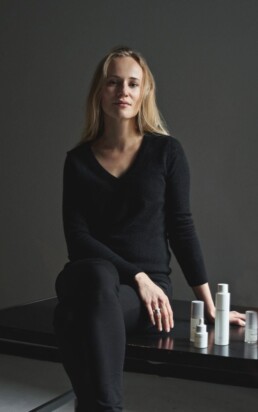
Jasmi Bonnén
More articles like this?
Culture, business & inspiration — straight from Copenhagen to your inbox. Join over 55,500 subscribers! We send out updates once a week.
Maiken Paaske aims to connect the world’s most remarkable outliers
Maiken Paaske aims to connect the world’s most remarkable outliers
🇩🇰 Du finder den danske version af denne artikel her.
Maiken Paaske is back as a founder, this time with Abeam, a network for “outliers.” These are the people who build extraordinary companies, shape investments, and drive innovation across borders and continents.
The platform brings together unicorn founders, top investors, and executives seeking meaningful connections, free from the noise of social media and unsolicited requests. For Maiken, it has always been about people, technology, and the opportunities that come from connecting the world’s most exceptional talent. We spoke with her about the vision behind Abeam, what drives her, and what Denmark could learn from the international tech scene.
Here is our creator interview with Maiken Paaske.
“We bring together the pioneers who are shaping the future in one place”
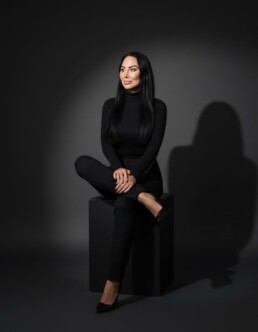
Maiken Paaske
Maiken, you’ve just launched Abeam. What is it all about?
“I would describe Abeam as ‘The home for outliers.’ It’s where the top founders, investors, executives, and leaders come together.
In venture capital and tech, the term ‘outliers’ usually refers to the 1% of people who do something truly exceptional—those who build extraordinary companies, create thousands of jobs, deliver significant returns to investors, and drive societal growth and innovation.
I think that term fits Abeam’s users perfectly. These are people who have had exceptional journeys and dared to do what very few would. Think unicorn founders, executives from public companies, top investors, founders who have made major exits, and so on.
We bring together the pioneers shaping the future in one place, enabling them to connect across countries and continents.”
“In short, you could say it’s like ‘Raya for business”
What problem are you trying to solve with Abeam?
*”In short, you could say it’s like ‘Raya for business.’ That might give some context.
Abeam exists to bring together people who can’t—or don’t want to—use platforms like LinkedIn, but still want to connect with relevant, like-minded individuals wherever they are in the world.
The people Abeam targets generally fall into two groups: some are extremely private, while others are very well-known.
The well-known are constantly bombarded with requests. Everyone wants something from them. Their LinkedIn inboxes are full of messages, but rarely are they meaningful or balanced.
On the other hand, there are the highly private individuals—those who aren’t active on social media and rarely appear in the press. They want to stay under the radar and avoid constant solicitations, but they still want to meet and connect with peers of similar caliber.
Abeam brings these ‘outliers’ together across the globe, allowing them to discover relevant people nearby. They can also join curated group dinners with others at their level and gain insights, advice, and support from people who truly understand them, because they see themselves reflected in one another.”*
What are your short- and long-term ambitions?
“The goal is to create the infrastructure that connects the world’s top outliers, enabling them to form relationships and alliances that can generate massive impact—for themselves and for the rest of the world.”
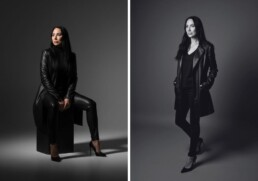
“Technology has always been a passion and a central interest of mine”
You’ve moved between startups, investing, and advisory work. When do you feel most in your element?
“From the outside, it might seem like there’s a big difference between them, but I don’t feel that way. I feel like it all connects and overlaps. The common denominator in everything I do is people. I truly enjoy working with inspiring individuals who have something meaningful to say, who don’t just follow the crowd, but dare to take risks, carve their own paths, and think outside the box—those who shape the world and drive us forward.
They give me energy! That includes both the clients in my advisory business, where I do thought leadership and PR for top founders, venture funds, and executives, as well as the same audience that uses Abeam. So, in reality, there isn’t that much distance between the different activities. It all blends together—in a good way.”*
And yet, you’ve also participated in many debates and knowledge-sharing sessions around technology, entrepreneurship, equality, and diversity. What drives you the most?
“Technology has always been a passion and a central interest of mine. It has shaped my education, my hobbies, and my career. I’ve always seen technology as a cornerstone of society and the future. If you want to be where decisions are made, where a lot is at stake, where you can have influence and shape the future, you need to understand tech. And many other factors intersect with that.
Investing is also a big part of the picture—venture capital gives new innovations a chance, which is why I’ve been involved in it. Beyond that, it’s primarily men who hold power in tech and investing today, so there’s clearly room for more diversity, especially if we want a future that reflects a diverse society. And I’ve always believed you can’t talk about business without talking about politics. Politics is in everything—especially when it comes to tech and investments—because there’s so much power and influence involved. So, in short, I feel it all connects and overlaps.”
"People have mixed opinions about Elon Musk, and he’s controversial in many ways"
Where do you think Danish founders have the most potential, and where are we still falling behind compared to the international tech scenes you follow?
“It’s funny—when I’m in the U.S., people think I’m so humble, but in Denmark, people see me as very ambitious and standing out. It’s fascinating how differently you can be perceived in these two places, and it probably says something about the differences between the markets. I think the ‘Jante Law’ still holds too much sway in Denmark.
It permeates our communication and culture—often unconsciously. Our discourse shapes our reality, whether we like it or not. As a result, ambition suffers, and it affects our ability to build companies here. Most people don’t dare to think REALLY big.
They’re afraid to stand out. They’re afraid to take risks. And honestly, the incentive to risk everything to build a company—where 95% fail within five years—is very low here. We’re so comfortable in Denmark: good salaries, security, a healthy work-life balance. We could learn a lot from Americans when it comes to generating excitement around entrepreneurship. They’re much better at hyping their founders, and that hype translates into real results. Entrepreneurs, investors, and the broader public get excited about new ideas. At first, it’s just hype, but over time it turns into real value. That’s exactly where Denmark is lagging.”
Who inspires you personally?
“People have mixed opinions about Elon Musk, and he’s controversial in many ways. But when it comes to entrepreneurship, there’s really no one at his level.
The problems he tackles are extraordinarily complex. He innovates critical infrastructure—not just with one company, but with many: PayPal, Tesla, SpaceX, Neuralink, Boring. It’s infrastructure for the future of civilization. He doesn’t do it once—he does it in parallel, simultaneously—and with great success.
So yes, Elon inspires me. Not because I want to be like him, but because he’s living proof that anything is possible. And at its core, entrepreneurship is exactly that: seeing the world as it could be and building the solutions that make that vision real.”
“A good workday is varied, yet carefully structured”
What does a good workday look like for you?
“It’s varied, yet carefully structured. I work a lot, but I feel free because I have the flexibility to plan much of it myself. I start my day reading the news, listening to podcasts, and getting in some morning exercise. I always prioritize deep work in the morning when I’m most productive, working with full focus.
Afternoons are usually filled with meetings and lighter, more flexible tasks. But I’m also the type who is always a bit ‘at work.’ If I get a good idea at 11:30 p.m. while falling asleep, I’ll grab my notes app and write it down so I can act on it the next day. My mind is always partially at work, full of ideas. I find it incredibly exciting.”
WEEKLY BRIEF
Culture, business & inspiration — straight from Copenhagen to your inbox. Join over 55,500 subscribers! We send out updates once a week.
Copenhagen’s Tivoli has grown into an international Christmas icon
Copenhagen’s Tivoli has grown into an international Christmas icon
🇩🇰 Du finder den danske version af denne artikel her.
No Christmas in Copenhagen is complete without a visit to Tivoli. It’s a cherished tradition for both locals and tourists – though it hasn’t always been so. It was only in 1994 that Tivoli first opened its gates for the holiday season. At the time, many shook their heads and asked: “Who would brave the cold for Tivoli?”
As it turned out, plenty of people would. As Tivoli’s founder Georg Carstensen once remarked, “Tivoli is never finished.”
In its inaugural year, Tivoli’s Christmas offering included 33 market stalls, 107 Christmas trees, and a single Santa Claus, all gathered around the main entrance. Today, the park boasts 1,007 Christmas trees and has become an international holiday phenomenon, famed for its lights, its magic – and as reason enough on its own to visit Copenhagen.
Last year, Tivoli celebrated its 24 millionth Christmas visitor, and this year the park expects its 25 millionth. To mark the occasion, we’ve rounded up 15 fun facts about Christmas at Tivoli.
Did you know? The 111-year-old Roller Coaster alone carries 172,609 visitors during the Christmas season.

Christmas at Tivoli 2025: Key figures
1) In just 12 days, 160,000 Christmas baubles were hung around Tivoli ahead of this year’s festive season.
2) For the second year running, Tivoli has been named one of the world’s best Christmas markets by CNN.
3) The roasted almond stall burns through around one ton of almonds each festive season.
4) The Christmas tree at the ice-skating rink stands 13 metres tall, adorned with 200 light strands and a total of 50,000 bulbs.
5) Her Majesty Queen Margrethe designed the costumes and set for The Snow Queen, featuring 36 dancers and 27 children from 10 different nationalities.
6) Mulled wine and hot chocolate are December favourites; at the festive village Bjældevang on The Lawn, over 55,000 steaming cups of cocoa and 54,000 cups of gløgg are served.
7) 15,000 fragrant hyacinths are used as part of Tivoli’s immersive Christmas experience.
8) Last year, visitors devoured over three tons of æbleskiver sprinkled with icing sugar and accompanied by 156 kilos of jam.
9) The 111-year-old Roller Coaster makes 172,609 guest rides alone during the Christmas season.
10) With over 180 years of history, Tivoli is the second-oldest amusement park in the world.
11) The Japanese Tower is adorned with 960 small light domes, making it one of Tivoli’s most photographed spots.
12) At Little Tivoli shop, over 20,000 Christmas decorations are sold each season—half traditional, half shaped like burgers, ice cream, and sweets.
13) Tivoli’s little red fire truck doubles as Copenhagen Fire Station No. 8, staffed round-the-clock during the festive season by firemen in holiday spirit.
14) Tivoli opens on Little Christmas Eve but remains closed on Christmas Day, December 24.
15) Boxing Day features plenty of festive fun, culminating at 11 PM with the season’s final fireworks, leading up to New Year’s Eve celebrations. Tivoli stays open through January 4, 2026.
WEEKLY BRIEF
Stay up to date with the most exciting stories, tips, and interviews.
Subscribe to our newsletter and get it all delivered straight to your inbox.
Already 55,500+ subscribers. We send out just once a week!
Zalando recruits former Nike executive to lead Nordic operations
Zalando recruits former Nike executive to lead Nordic operations
🇩🇰 Du finder den danske version af denne artikel her.
Europe’s leading online fashion platform, Zalando, has appointed a new Nordic director. Sebastian Becker takes the coveted role, succeeding Lisa Schöner and previously Fabio Baum.
He will have overarching responsibility for Denmark, Sweden, Norway, and Finland, leading efforts to strengthen Zalando’s position while cultivating relationships with customers, partners, and brands.
In Denmark alone, Zalando is the country’s most popular online retailer, generating around €2.8 billion in sales across Europe in the third quarter and serving nearly 55 million customers annually.
The Nordics remain a key priority for Zalando, making Becker’s role central to the company’s strategy to build the leading fashion and lifestyle ecosystem in the region.
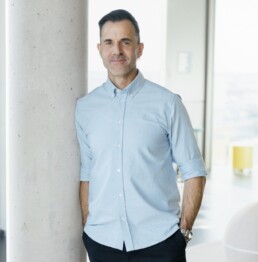
Sebastian Becker, Zalando
Former Nike executive
Sebastian Becker comes to the role after holding several senior positions within Zalando, including Head of Markets Planning & Trading for the DACH region and the Benelux markets.
Prior to joining Zalando, he spent several years at Nike, working in business development across Europe and at the company’s global headquarters in the United States. His experience spans retail, e-commerce, and omnichannel operations, and he is recognized for his strategic planning and commercial execution expertise.
Becker holds a Master of Science in International Business from Maastricht University.
dontt.dk will follow up with an interview, giving him the opportunity to elaborate on his ambitions for the Nordic region and how he plans to contribute to Zalando’s continued growth.
WEEKLY BRIEF
Stay up to date with the most exciting stories, tips, and interviews.
Subscribe to our newsletter and get it all delivered straight to your inbox.
Already 55,500+ subscribers. We send out just once a week!
Les Deux in the Spotlight After London Stunt
Les Deux in the Spotlight After London Stunt
🇩🇰 Du finder den danske version af denne artikel her.
It was only a few weeks ago that we reported on Les Deux opening their first store outside Scandinavia, in Paris’s Marais district. (Read more here.)
But France isn’t the only place where the Danish menswear label is making waves. In the UK, Les Deux has grabbed headlines, expanding from 24 to 42 carefully selected stores in just a few months – and is now planning to open an office and showroom in London.
“…meanwhile, Les Deux has recorded a remarkable 225% increase in turnover this year”
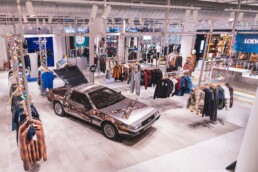
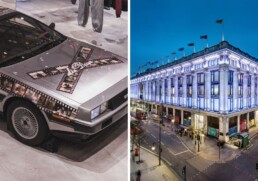
Les Deux celebrated its launch in the very heart of Selfridges’ iconic menswear floor!
The brand is stocked in more than 1,000 handpicked stores spanning four continents.
The UK push reached its peak last week with the launch at London’s iconic Selfridges. The debut was marked by a DeLorean wrap on the store’s famous DMC-12, featuring a film-strip motif inspired by the brand’s Winter 2025 campaign, which pays homage to classic 1990s sitcoms.
The stunt caught the attention of Fashion Network, whose daily newsletter reaches over 900,000 subscribers, putting the Danish label firmly in the spotlight.
Morten Kristiansen, Les Deux’s CCO, told the publication that the brand’s energy is palpable, and the UK market plays a key role in its international expansion:
“There’s so much energy around the brand right now, and it’s particularly visible in the UK, where partners like Selfridges are helping set the pace for what comes next.”
Today, Les Deux is stocked in over 1,000 stores across four continents, with key partners including Bloomingdale’s, KaDeWe, Nordstrom, De Bijenkorf, Galeries Lafayette, and La Rinascente.
The expansion doesn’t stop at the UK. In Ireland, the brand has grown from zero to 12 stores in just nine months, including prestigious names like Brown Thomas/Arnotts and Avoca. Meanwhile, Les Deux has recorded a remarkable 225% increase in turnover this year, building on 13 consecutive years of growth.
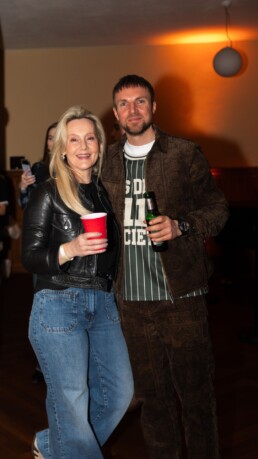
On the right: Morten Kristiansen, CCO of Les Deux, pictured with Nichole Strydom, Commercial Director at Zalando, during Les Deux’s YALE launch in Berlin.
WEEKLY BRIEF
Hold dig opdateret på de mest spændende historier, tips og interviews.
Tilmeld dig vores nyhedsbrev og få det hele direkte i inboxen.
Allerede 55.500+ på listen. Vi sender ud 1 gang om ugen!


